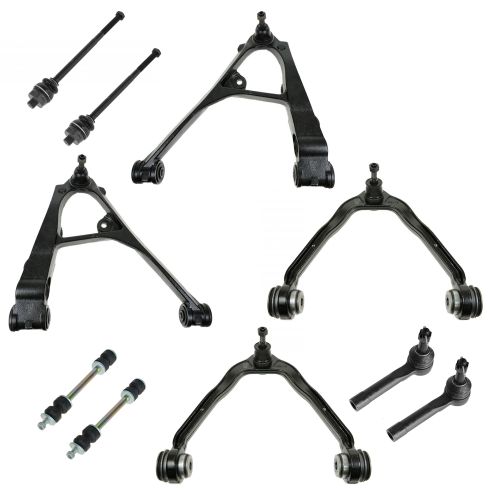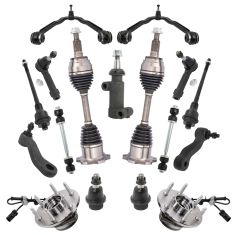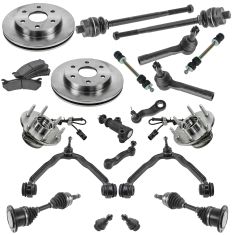1ASFK03613-Chevrolet GMC Cadillac Front 10 Piece Steering & Suspension Kit TRQ PSA58569

Replaces
2005 Cadillac Escalade ESV Front 10 Piece Steering & Suspension Kit TRQ PSA58569

Product Reviews
Loading reviews
4.69/ 5.0
35
35 reviews
Steering kit
March 3, 2017
This kit worked perfectly. Fit exactly like the description said. The parts went together easily. Plus I saved about $300. I definitely will be ordering more parts for my truck in the future from 1A auto. Thank you.
Right parts on time
July 22, 2017
The only problem I had was did not get my emails during to buying process
August 2, 2017
Thank you for all your help got my truck right together
Very nice product, very nice fit
August 9, 2017
I ordered this for my 2006 Avalanche and was pleased that the products were as good or better than the original parts. I only wish I could have found a kit with these parts plus the two pitman arms to complete the steering.
Revitalized 03 Silverado Z-71
September 3, 2017
Parts were received quickly and everything fit perfectly! One upper control arm was missing a grease zerk and a replacement was sent promptly. The only looseness is now due to a worn steering gear box. The best part is the how to videos provied to be an excellent reference tool that removedall of the guesswork, especially in regards to the tie rod ends. They barely had to adjust the alignment! Excellent products and all around service.
New front End
April 13, 2018
The parts fit well The online videos were very helpful Some of my order was lost in the mail but A1auto sent me replacements customer service was very helpful. Im glad I decided to do it , it saved me $2,800 Is what the dealership was charging for 16 hours labor.
Frint end parts
July 23, 2018
Parts all fit great, everything was as advertised.
Seems to be good quality
September 4, 2018
Everything come as pictured. Fast shipping. Seemed to be of good quality great price. Got email to late to enter drawing.
Great quality
November 8, 2018
Just recently installed these on a 2001 Chevy Tahoe everything fit perfectly and insulation was a breeze all parts and Hardware was in box. Surprisingly a better quality than OEM equipment!! I went ahead and installed shocks as well and the ride quality is like New. Highly recommend if you need new suspension shipping was also fast and easy received my parts within 2 business days thanks again A1 Auto
Front end kit
November 11, 2018
Got it on time but the shipping company had ripped the box and lost a part so I called them to ask for it and they sent it right out and were very nice I will definitely use them again.
Steering kit changeout
November 22, 2018
Ive ordered a bunch of parts for my vehicle, by far the best price. Have never had any problems at all with any orders, always on time and always right parts. Instructional videos for each parts are awesome, the only parts place that I know of that does it and it helps tremendously. Would recommend to anyone.
OK Steering
January 6, 2019
The 10 piece kit arrived in great timing. Yukon bad up and riding great.
Exactly what I ordered.
March 31, 2019
I'd definitely reccomend this!
Great parts they fit perfect.
June 24, 2019
Thank you 1Aauto your parts work assome. I had to replace this on my Tahoe this month. Due we took a trip to Lake Tahoe. Well my Tahoe feels like new. Great price and fast delivery did it. I am already looking for parts for my dad's old pick up truck 1983 Chevy 350 V8, I need to fix it. Bring it back to life I know I can count on 1AAUTO. Gracias. Alverto Martinez
Great service & quality
August 18, 2019
I accidentally ordered 2 front end suspension kits. They promptly accepted return of one.....at NO cost to me. This was a very heavy package that would have cost $ to ship. I got every part promised quickly. Every part was a perfect fit. And their online dyi videos are excellent.
Everything Aligned Properly
August 25, 2019
even though I had parts for my front-end from multiple vendors, these parts fit perfectly
Great product
September 4, 2019
Product arrived before it was supposed too, had all the pieces, and was a reasonable price!
Suspension kit
October 26, 2019
I used 1A Auto videos which were very helpful in completing my work. I spent about $850 on all the parts but I bet a shop would have been around $2000 or more. I just have to see how durable these parts are. Hopefully they are
Tie rods loosey goosey
November 2, 2019
Installed this complete set up. Went to most referred alignment shop in Seattle area to get alignment...they said tie rods are crap, get qualty ones and replace before getting alignment done...
Perfect fit EXCEPT there are no grease zits
January 12, 2020
Installed this on my 2002 Suburban. Everything fit perfectly and all bolt holes for brake lines and wheels speed sensors where in the correct spot.
The only draw back is that the new COMPLETE kit did not include grease zits for the upper and lower ball joints. I could not remove the factory installed grease zits. They didn't have a way to unscrew them and I destroyed them trying to remove them. I wish there had been a note that GREASE ZITS NOT INCLUDED. I would have picked them up before I pulled the suspension off and saved my self a trip to the parts store.
Suspension kit
April 27, 2020
Good kit for updating pretty much your entire front end only complaint is the outer Tie rod ends not being greasable but other than that worked out great.
For: 1ASFK03613-Chevrolet GMC Cadillac Steering & Suspension Kit 10 Piece Set
September 16, 2020
Kits were a perfect fit, and truck runs smooth as ever...
Perfect
August 11, 2021
All products came as described. Nice part ball joints all had grease zerks. Nice added bonus. Your videos are second to none.
Quality as usual
August 13, 2021
On time delivery, quality parts, fit as advertised.
Good price fast delivery
January 27, 2022
Good price fast delivery. Everything worked perfectly.
Front suspension
February 6, 2022
The kit was a success. I mounted on the vehicle and it fit perfect. Thank you!!
February 7, 2022
Everything fit good
So Far So Good
May 8, 2022
Good so far, I'm just a little concerned about the tie rod ends but nothing has gone wrong with them and I put aftermarket 24 inch rims and 33 inch tires on my truck, so I'll see how long they hold up.
July 5, 2022
Best front end suspension purchased ?? keep up the good work
Very good product and very affordable
March 27, 2023
They were very affordable and a direct fit and replaced the original uppers and lowers from factory. They were in very good condition and had no flaws. The shipping was very fast. I will definitely buy more products from 1A auto.
After seeing the product first hand I will definitely be a repeat customer
[{"url": "https://wac.edgecastcdn.net/001A39/prod/media/pNISJll75W64CYGsite/2ed1edbcf55c88a4178b08cc88a84b29_1687019833605_0.jpeg", "caption": ""}, {"url": "https://wac.edgecastcdn.net/001A39/prod/media/pNISJll75W64CYGsite/939cf8d3e3cc8fab60980ff63544714a_1687019833605_1.jpeg", "caption": ""}]
June 17, 2023
I received my order, inspected all the parts and was surprised to the heavy duty quality and sealed bearing. Wish I know about A1 Auto years ago. I just placed my second order 1 day after my first time experience. A1 is going to be my go to from know on.
Not bad
November 11, 2023
So far good stuff
Great Products
November 21, 2023
These parts came well packaged and complete. Easy install and feel good. We will see if they last a long time. No grease fittings on the outer ball joints.
June 12, 2024
Installed two years ago, no issues
Front End Parts
August 15, 2024
So far so good. But it had only been a month or so
Customer Q&A
Do these parts fit 2003 Chevy Suburban LS 4X4?
June 4, 2018
10
Yes, according to the information you supplied, the part you're looking at will be correct for your vehicle. If you have any other questions or would like to place an order with one of our customer service representatives, please feel free to give us a call.
June 4, 2018
Peter L
10
If the 4x4 suburban is a half ton and hads torsion bars, then yes this kit will fit.
June 6, 2018
Kurt J
10
Yes
June 6, 2018
Kurt J
10
I think so
September 4, 2018
M S
Does this kit come with the alignment hardware for the upper control arm?
May 29, 2019
10
New hardware is not included with this item. You may be able to reuse your original hardware if it is in good condition.
May 29, 2019
Christa R
Thomas H. What was the "response from staff" and their proposal?
February 20, 2022
will this work for non-4x4 suburbans?
March 24, 2022
10
Kit number 1ASFK03613 will fit non 4WD Suburban's. 1ASFK01169 only fits the 2WD Suburban.
March 24, 2022
Andra M
Do these parts work on 2006 Chevy tahoe?
June 10, 2023
10
Yes, this part will fit your vehicle.
June 13, 2023
Emma F
WillTRQ PSA58569 fit 2006 Chevy Tahoe 2WD?
June 10, 2023
10
Yes, this part will fit your vehicle.
June 13, 2023
Emma F
Do the parts have grease fittings?
June 11, 2024
10
No. Our steering and suspension components are pre-greased and sealed for long life and do not require the extra maintenance typically required by greaseable versions.
June 11, 2024
Kemal S
10
Yes, grease fittings included.
June 12, 2024
Scott M
10
Yes
June 13, 2024
Aaron L
Cadillac is a registered trademark of General Motors Company. 1A Auto is not affiliated with or sponsored by Cadillac or General Motors Company.
See all trademarks.























